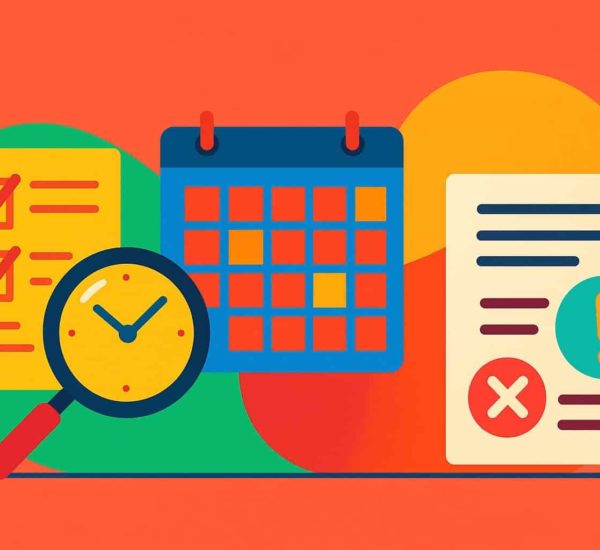Many employees face burnout because they don’t prioritize the work or follow any work schedule. As a result, they spend more time managing work and struggle with productivity issues.
In 2020, a survey called ‘Anatomy of Work’ was conducted by Asana. According to this survey, 87% of the employees spend a minimum of two hours extra every day, but still, 25% of those employees miss deadlines every week. Employees can use a time-blocking template to deal effectively with productivity and work-induced stress.
What is time blocking?
Time blocking is grouping similar tasks to reduce the workload. A time-blocking template is a sheet where the work is distributed across the week in a well-planned manner.
The time-block sheet schedules every single hour that the employees can utilize to boost their productivity. It also includes time slots for exercise, entertainment, hanging out, or anything that helps them to work better.
How does it work?
A time-blocking template works in a manner that is similar to the timetable that we use in schools. However, instead of allocating specific time for each subject, the employees need to recognize similar tasks and group them to reap the benefits of improved productivity and time management. The time allotted for each group can be less or more, depending upon their priority and extensiveness.
For example, suppose that some remote working employees work for eight hours every day and start their work at 9 am. Now, they can allocate one hour from 9 am to 10 am for reading emails and replying to work-related messages.
The time from 10 am to 11 am can be reserved for team meetings, calls, and work coordination, and the time from 1 pm to 2 pm can be allocated for lunch and other small breaks. The remaining 5 hours can be given for the actual work. Each group is a time block that helps the employees to complete their work efficiently.
A time-blocking template contains a fixed schedule with intervals or breaks. It allows employees to set particular time blocks for lesser essential tasks to focus on their core tasks effectively.
How to create a time-blocking template?
Here is a step-by-step process that will guide employees in creating a time-blocking template:
Step 1: Understanding the differences between daily, weekly, and monthly planners
Employees must understand the differences between daily, monthly, and weekly blocking planners.
In a daily blocking schedule template, one can use 15-minute, 30-minute, or two-hour time blocks to group various activities. Weekly planners can be divided into a six-day or five-day work week per the requirements. Each time block can be one hour or two hours, depending upon the nature of the work.
If the same project continues for an entire month, the employees can also adhere to the monthly block schedule templates. The monthly planner needs to be divided into 30 or 31 days. After that, each day will be divided into multiple one-hour or two-hour time blocks.
Some tasks can be repeated after one or two days, depending on the work priority. The top priority work might be included in the daily time-blocking template. Also, the less important tasks like attending client calls or replying to emails to be completed daily will be included in the daily planner.
Once they understand how to follow different planners without getting confused, they can start creating time-blocking templates.

Step 2: Begin with high-priority work
High-priority work means the work for which an employee gets paid. The employees must focus more on high-priority work and allocate a significant chunk of their time.
However, sometimes, work might not be their priority. The employees might have to relax, spend time with family or care for their partners. They must start with high-level priorities, irrespective of whether personal space or work tops their priority list.
Step 3: Start creating time blocks
The next step in making a time-blocking schedule is to set schedules. For this, first, they need to focus on their morning schedule and determine how much time they need to groom themselves.
They can reserve time blocks to unwind from work and focus on personal goals. A particular time slot can be blocked for nurturing hobbies and interests.
For example, software developers who indulge in trading and whose hobbies include writing and working out can create a schedule like the one given below:
Monday
- Shower and breakfast: 7 am to 8 am
- Trading lessons and research: 8 am to 9 am
- Trading: 9 am to 11 am and 2 pm to 3 pm
- Coding: 11 am to 1 pm, 5 pm to 7 pm
- Lunch: 1 pm to 2 pm
- Reading books: 3 pm to 5 pm
- Evening walk and meeting friends: 7 pm to 9 pm
- Dinner and spending time with family: 9:15 pm to 10:15 pm
Tuesday
- Shower & Breakfast: 7 am to 8 am
- Trading lessons: 8 am to 9 am
- Trading: 9 am to 10 am & 2 pm to 3 pm
- Coding: 11 am to 1 pm & 4 pm to 6 pm
- Lunch: 1 pm to 2 pm
- Reading books: 3 pm to 4 pm
- Evening walk: 6 pm to 7 pm
- Engaging in some writing stuff: 7 pm to 9 pm
- Dinner and spending time with family: 9 pm to 10 pm
The time-blocking template for other tasks can be created according to their preferences. This example shows that although work is a priority, hobbies and interests are equally important.
Similarly, each day need not be divided into the same blocks. Also, by creating a block schedule template for the entire week, the employees will have a fair idea of how they should approach a week.
Sometimes, they might not be in the mood to follow the schedule strictly. To deal with mood swings, they can write down activities they would prefer to do instead. These things can be included in a bracket to give preference to the primary tasks.
If an individual is not in the mood for reading or writing, they can indulge in activities such as watching videos, binging on TV shows, etc.
Step 4: Give time for both critical and less important tasks
A time-blocking template should reserve time for meaningful and less critical tasks. For example, the primary task of a software developer is coding.
However, reading emails, responding to client messages and calls, sending reports, and other less important tasks cannot be ignored as well. The employees must find the right balance by setting aside time for each job per their priorities.
Also, while creating a time-blocking template, one must realize their productivity pattern. Some employees are the most productive during the early hours of the day. Employees can wake up early and use their productive time for their core tasks.
Some employees might be productive at night. Such employees can focus on their work at night, but they should also set some time aside in the daytime so they don’t feel anxious throughout the day.
Step 5: Dividing blocks into bursts
Sometimes, it is not practical to devote an entire time block to a single activity. For instance, we receive emails at irregular hours every day. Some emails need to be responded to immediately. Therefore, dedicating one hour to all the emails might not be an intelligent use of the block schedule template. Instead, we can divide the time into small bursts to focus on the other tasks without getting disturbed.
For example, if the employees reserve an hour to replying emails, they can divide it into four 15-minute blocks and schedule it at odd hours across the day.

Tips For Creating Time-Blocking Templates
The above steps give a basic understanding of what a time-blocking template is all about. Each template is different based on the requirements and tasks to be completed on priority. Here are some tips that the employees can use to create a time block schedule template:
1. Add buffers after each task
Following a schedule as per the scheduled time blocks can be strenuous. The employees can add time buffers of 10 or 15 minutes after each task. These buffers will help them recuperate and focus their energy on another task. Buffers will also allow them to disconnect from their work whenever required.
2. Lunch is not the only break
Employees need multiple breaks apart from lunch. They might need to take a long walk, stretch their body for some time or just listen to a song. They must include these breaks in their time-blocking schedule templates.
3. Not necessary to follow the entire schedule strictly
Employees are not machines but humans who can think for themselves. So, it is not necessary to follow the entire schedule very strictly. If individuals feel like hearing a song for five minutes after every 1 hour of work, they can do so.
Similarly, activities like stretching that barely take a minute or two cannot be ignored simply because they aren’t mentioned in the time-blocking template. These templates give an idea of how employees should go about their work. The employees must follow a time-blocking template while responding to their instincts as they would normally do otherwise.
4. Giving too much time to simple tasks
The employees need to be realistic when allocating time to the tasks. They cannot assign long hours for simple tasks. At the same time, they should not give less time to more complex and time-intensive tasks.
Not focusing only on productivity: Too much focus on productivity can also be the reason for burnout. Employees should also focus on relaxing and rejuvenating their minds when needed.
5. Don’t schedule all the days
Following the time-blocking template continuously can make an employee feel tired at work. They must also leave some days when they can do their work or relax as per their wish.
6. Keep others in the loop
When employees follow a time-block sheet, they must keep their subordinates in the loop. It means that they must inform them about their schedule. Remote working employees can tell their family members. Support from associates or family members will help them adhere to their time-blocking template.
7. Make the changes as required
Sometimes, the employees will have to make specific changes in the time-block sheet due to a new project or other tasks assigned by their seniors. They must not hesitate to change their time-blocking templates as per the situation.
8. Using apps
There are some time-blocking apps available for smartphone users. They can use these apps to create effective and well-planned time-blocking templates. However, even if they don’t have access to such apps, simple tools like calendars can also aid.
Conclusion
Time blocking is creating time blocks for various tasks. However, one can also group multiple activities into one block if they are similar. This concept is called time batching, a subset of time blocking. To create a perfect time-blocking template, the employees can adhere to all the tips and steps mentioned in the above paragraphs. If they still have doubts, they can refer to online sources and develop a more profound understanding of how things work in a time-blocking template. They can also refer to samples of time–blocking schedule templates that are readily available on the internet.



